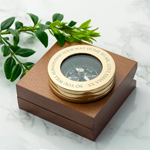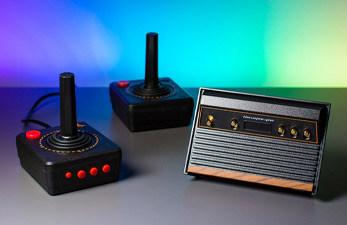Remote control helictopers, aeroplanes and cars move over and make way for the The Parrot AR.Drone 2! As seen on Channel 5's The Gadget Show, CITV's Cool Stuff Collective and the BBC's Top Gear, this is the world's first Quadricopter and represents an unprecedented phenomenon as the ultimate flying toy!
Easily controlled by Wi-Fi using a smartphone or tablet, the Parrot features a high definition camera with a video recording facility, plus flight data sharing, a patented piloting mode, and an innovative pressure sensor for increased stability at any altitude.
Parrots outstanding AR.Drone 2.0 offers just about every possible option on the enthusiast's wish list, and can even perform 360 degree flips on command! The horizontal forward facing camera transmits real time video, showing exactly what the quadricopter sees on the smartphone's screen. It has a 720 pixels HD resolution, streaming 30 frames per second, so you can record what the average bird or your Parrot Quadricopter sees.
For gaming purposes, this camera can also recognise specific shapes and colours to show augmented reality elements on the screen. Now you can record and share your flying experiences with others, thanks to the new AR.FreeFlight 2.0 piloting application. Additionally with the Travelling Feature, the pilot can film HD video sequences like a professional. Simply select the direction of travel, plus the duration, and the AR.Drone 2.0 does the rest automatically.
The Parrot AR.Drone 2.0 connects to the device via Wi-Fi. After connection, all the onboard instruments appear on screen with a cockpit view. Press the take off button briefly and the four powerful brushless motors turn on, the AR.Drone 2.0 will take off by autopilot and hover about one metre above the ground.
Flying is very simple, with your thumbs placed on either side of the screen, a control button automatically appears beneath. Press and hold the left button and the AR.Drone 2.0 follows the movement of the pilot's device. It moves forward, backwards or sideways when you tilt the tablet in the appropriate direction.
Slide your finger vertically or horizontally over the right button, and the quadricopter rises, descends or slowly rotates left or right. With a 3D magnetometer, the AR.Drone 2.0 knows its precise position with respect to the smartphone, which becomes the reference point. The pilot no longer needs to worry about the orientation of the AR.Drone 2.0. Experienced players may still select Relative Flight Mode, to switch back to conventional control. This disables the magnetometer, and the pilot can manage the quadricopter's orientation without assistance.
Surprisingly stable at any altitude, the AR.Drone 2.0 contains several micro electromechanical systems, a 3-axis accelerometer, a 3-axis gyroscope, a 3-axis magnetometer and a pressure sensor to correct the alignment automatically. The quadricopter generates its own Wi-Fi connection, with a range of up to fifty metres. It will fly continuously for twelve minutes with the 1,000 mAh rechargeable lithium polymer battery provided, whilst recharging from the mains in an hour and a half. Four high performance propellers, specially designed for the AR.Drone 2.0, make exceptionally smooth flights possible. A second vertical camera placed beneath the quadricopter, can be selected to show live video on screen, and additionally measures the craft's speed using an image comparison system.
Suitable for beginners and experts, the AR.Drone 2.0 features a tough carbon fibre central cross. It is supplied with two distinctly different hulls, made of flexible expanded polypropylene foam. They are both highly resistant to impact, and protect the more delicate internal parts. For outdoor flight, the lightweight streamlined hull reduces wind resistance and preserves the quadricopters excellent handling and stability, even in a light breeze. When operating the AR.Drone 2.0 with the indoor hull, the four foam rings protect the blades, and your furniture from impact. As a safety feature, the rotors are designed to stop immediately upon contact. Two pairs of red and green lights are positioned on the landing gear to assist orientation.
 Sign In
Sign In


































































































 Free Same-Day Click & Collect!
Free Same-Day Click & Collect!
 Get more time to pay*
Get more time to pay*





